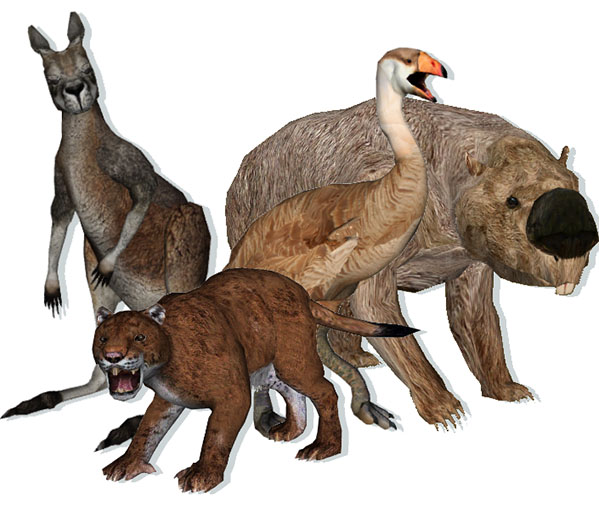
|
Search JoyZine with Google Site Search! |
Australian Megafauna
Evidence has emerged that it was harsh climate, and not human habitation of the continent, that was the slayer of the car-sized wombats, 2.5-metre tall kangaroos, sheep-sized echidnas and other extra-large beasts that once roamed the outback, according to Queensland University of Technology research. Gilbert Price and Gregory Webb, in the Australian Journal of Earth Sciences, said that Queensland megafauna of the Pleistocene era was already drought-stressed before going the way of the dodo. The new study backs the findings of a Melbourne-La Trobe university team which announced in August that megafauna at Lake Menindee, in western NSW, was already extinct before humans arrived in that region. Both studies contradict the view of Australia's high-profile scientist and intellectual, Tim Flannery, that early Aborigines wiped out Australia's megafauna. The Queensland researchers unearthed and studied megafauna remains from the Queensland region of Darling Downs, which borders New South Wales, at the Kings Creek catchment. "No evidence of human interaction with pleistocene remains was observed in the site or in other nearby sites," says their article. "The apparent progressive megafaunal extinction on the Darling Downs does not support a sudden 'blitzkrieg' model resulting from human hunting. The gradual demise … is most parsimoniously attributed to increasing aridity in southeastern Queensland." Dr Price said the drought profile of the fossil kangaroo populations was "identical to that of a modern drought-stressed kangaroo mob". He said that if human habitation wiped out the megafauna, the fossil record should show the animals being wiped out at the same point in time. But the Darling Downs site showed "a progressive, three-stage extinction over time that relates to periods of climate change". Dr Webb said it is hard to pin down the exact dates that the megafauna died out, but it was between 80,000 and 30,000 years ago, during which time Australia was becoming progressively drier. Humans are believed to have come to Australia between 48,000 and 60,000 years ago. He said the dry weather, or aridity, was associated with the last ice age and the spread of glaciers throughout the world. Because the weather was so cold, there was little evaporation, little humidity and, therefore, little rainfall, he said. Much more research is needed to get a clear picture of the diversity of megafauna species which lived in Australia during the Pleistocene Epoch. However, a representative list of the species found so far would include the following:
|
